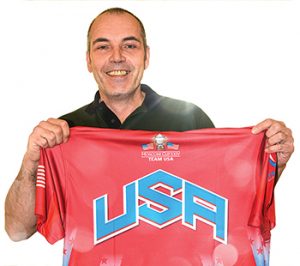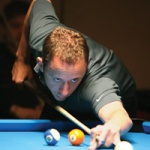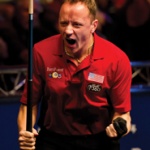Ruijsink to Coach U.S.
Ruijsink replaces Mark Wilson, who helmed the U.S. squad for three years, coming closest to victory in 2015, when the U.S. lost, 11-7.
With Team USA posting just one win in the last 11 Mosconi Cups, Matchroom said it was seeking a game-changer to “revive America’s flagging fortunes,” even if it meant appointing a European coach.
The announcement caught many American players and fans by surprise. Numerous posts on social media decried the decision as “an insult to the Americans,” while others applauded the selection as America’s “best chance” to become competitive again.
“The reason to take on this job is quite obvious,” Ruijsink commented in the Matchroom release. “I am an authentic lover of the game and especially of the Mosconi Cup. In 25 years of coaching, the Mosconi Cup has proven to be by far the most exciting event in the world of pool.
“As a coach in pool, there is no higher goal then working in the ‘home of pool,’ the U.S.A. My entire coaching career has been founded on seeing the American players compete at the World Championships in Bergheim, Germany, in 1990. There I saw Earl, Varner, Davenport, Mizerak, Mataya, Lebron and a young Johnny Archer, and they made me love the game even more.”
Ruijsink is credited with coaching Holland into a pool powerhouse, mentoring stars like Alex Lely, Niels Feijen and Rico Diks in the ’90s and early 2000s. In recent years, he has been coaching in Russia, developing a talented crop of players, including recent World Pool Series champion Ruslan Chinahov.
“I was shocked at first,” said American Justin Bergman, who has played on the last three U.S. squads. “But I don’t think it’s a horrible idea from a player’s view, since he probably has good ideas and he’s a knowledgeable coach. I think we should all support him.”
“I think it’s good, since he was so huge for Europe’s team,” echoed Skyler Woodward, Team USA’s best player over the past two Mosconi Cups.
According to Matchroom, Ruijsink will get to hand pick his five-player team, so long as each player is ranked in the top 10 in Mosconi Cup points in 2017. Additionally, Ruijsink plans to travel to the U.S. several times during the year to meet with and observe potential team members.
Ruijsink’s first decision was selecting Archer as his vice-captian.
The Big Time
It’s been 10 years since the International Pool Tour died. How will history judge the short-lived $13 million venture that showed the promise and peril of attempting to bring pool into the big time?
By Nick Leider
It almost seems like a fever dream, now that it’s been a decade since its death. The International Pool Tour, founded and funded by infomercial maven Kevin Trudeau, held four events in 14 months that awarded more than $6 million in prizes. Pool had not seen — and most likely will not see — anything like this in the history of the sport.
Efren Reyes, winner of two tournaments, pocketed $765,000. The matches were live broadcast across Europe in primetime. Players were told of guaranteed income in the six figures.
But now, 10 years after the IPT’s final event, the World Open, left players with little more than IOUs for $3 million, Billiards Digest revisits the IPT’s unbelievable rise and equally astonishing fall. While setting the record straight on what remains one of the most controversial eras in modern pool, one question begs for an answer:
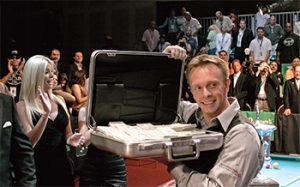
Though short-lived, the IPT still showered pros like Thorsten Hohmann with briefcases full of cash.
What was the IPT’s lasting effect on the game we love?
The Facts
Before telling the story of the IPT, it’s imperative to present the facts that are often lost in the legend of the IPT.
First, every player who won money received what they were due. The $3 million in prizes from the World Open, the abbreviated tour’s last stop, were awarded, though it took 14 months and a series of installments to meet the tour’s obligations.
Second, players did lose $2,000 paid to play in qualifying events for a tournament that never happened. The IPT postponed and then cancelled its future events, leaving those who had ponied up that qualifier money without recourse.
“Some players received that money back and others did not,” said Deno Andrews, the IPT tour director who handled day-to-day operations. “I can’t remember how many ended up losing that money. It was not that many players — with that said, any [number] more than zero was too large.”
Finally, among the top players who competed on IPT, the consensus was that, despite the missteps, broken promises and eventual failure, it was a good thing while it lasted.
“My brothers on tour, we were all really happy about Trudeau and the IPT,” said Rodney Morris, who earned $150,000 with a runner-up finish at that maligned World Open. “We made some money and we had a great time. We were more than happy to be a part of it. We wished things would’ve worked out, but I have nothing against anyone.”
Thorsten Hohmann, who netted $350,000 by winning the North American Open, agrees.
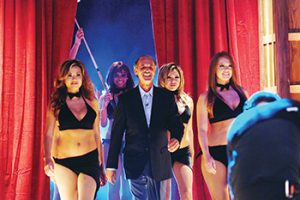
Trudeau’s events were lavish affairs, brimming with pomp and circumstance, as showcased in the Battle of the Sexes match between Loree Jon Hasson and Mike Sigel.
Still, the IPT, coming on so strong and crashing so quickly, affected much more than players’ bank accounts. To see these impacts, it’s worth starting at the beginning.
The First Time
The World Championship Open (Aug. 20, 2005)
Trudeau’s entry into professional sports was a moment of serendipity for pool, a bit of luck for a sport that desperately needed it. The women’s game, buoyed largely by the WPBA Classic Tour, was in decent shape, with events regularly appearing on ESPN and top players able to support themselves with tournament winnings. The men’s side, though, had little as far as organization. The Professional Billiards Tour Association had collapsed in the decade prior. Outside of a few big world championship tilts and the annual U.S. Open 9-Ball Championship, organization was minimal and cooperation was almost nonexistent.
The seeds of the IPT, though, were planted a decade earlier in 1994. Trudeau was already a successful businessman, but he was not yet riding what would be a wave of commercial success based largely on his “Natural Cures” brand, including a New York Times bestselling book and ubiquitous late-night infomercials. Long a fan of pool, he caught a radio advertisement for an exhibition in the Chicago area featuring Hall of Famer Mike Sigel.
“Kevin got in touch with me saying he wanted personal lessons,” Sigel said. “We became friends and I would see him every few weeks. And then I got it in my mind. I said, ‘Hey, you got all this money and you love pool. Let’s do something for the game.’
“I nagged him for 10 years, saying we should do something together. Finally, one day when we were playing pool, he said, ‘Let’s do it.’”
The two scribbled down some notes about prize money. Sigel imagined top prizes around $100,000, with other top finishers pocketing proportionally big bucks. Trudeau, though, had bigger ideas from the start.
“He looked at all that, without even adding it up,” Sigel said, “and he said it’s got to be bigger. For him, from the start, it wasn’t a matter of doing something. It was a matter of how big it was going to be.”
Eventually, the plan was to hold a kickoff challenge match in August 2005 between Sigel and fellow Hall of Famer Loree Jon Jones in Las Vegas. Dubbed the World 8-Ball Championship, the battle of the sexes paid the winner $150,000 with a consolation prize of $75,000. Trudeau threw a lavish party the night before the event, replete with celebrities. On the day of the Sigel-Jones match, the celebrities (actors Paul Sorvino, Allison Janney and Anthony Anderson, rapper DMX and boxing legend Thomas Hearns among them) entered the arena in true red carpet style.
Deno Andrews was taken with Trudeau’s insistence on this being like nothing pool had seen before.
“Everything had to be big. We did nothing half-assed,” Andrews said. “What gets him going is entirely different than what gets the rest of us out of bed. He wanted it big and he wanted it immediately.”
By August, the IPT had crash-landed on the pool world.
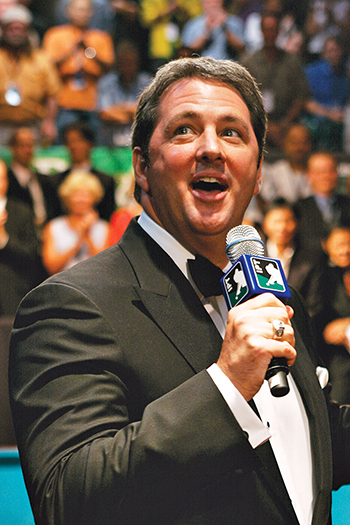
With media maven Trudeau at the helm, “everything had to be big.”
If a guy wanted to get pool players’ attention, big money and bright lights aren’t the worst ways to do so.
The Best of Times
The King of the Hill 8-Ball Shootout (Nov. 30-Dec.4, 2005)
The North American 8-Ball Championship (July 22-30, 2006)
The IPT initially started with 150 players hand selected by Trudeau and the IPT brass. Potential tour members had to apply for a spot on this lucky list, which may be the first and only time pool players put together resumes en masse.
A group of players automatically qualified based on past performance. Think Johnny Archer, Efren Reyes, Rodney Morris and other world-class talents. A dozen living Billiard Congress of America Hall of Famers received automatic entry and a $30,000 bonus simply for being part of the tour. Other players had to apply to tour membership. Darren Appleton, then a professional English 8-ball player but largely unknown in the U.S., emailed his application to the tour hoping that his unmatched record in a slightly different discipline would earn him a spot. (It did.)
The King of the Hill event, however, would only see 42 players compete for the $1 million prize fund, with $200,000 going to the winner. Still, the IPT managed to get all 150 players to Orlando for the event, because a mandatory players meeting promised to detail just what the tour had in store for its first year.
“It was the greatest speech I’ve ever heard,” said Thorsten Hohmann, of Trudeau’s pitch to the players. “It was incredible. I wasn’t really too aware of everything until I got to Orlando and heard Kevin. That made me realize: Holy shit. This is something big.”
Appleton, whose involvement with the tour led to him ditching English 8-ball for the American variety, was equally blown away.
“That players meeting, [there] was amazing excitement. I felt like a professional sportsman,” he said. “This was the biggest thing to happen for pool.”
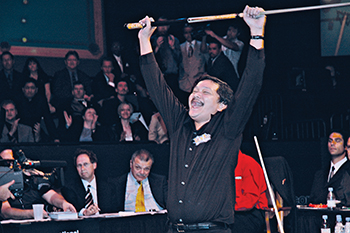
Reyes scored pool’s biggest ever prize.
Six months later, the North American Open brought 200 players to the Venetian in Las Vegas for a chance at the $2 million purse. The top prize was $350,000, the biggest single payday in the history of pool. EuroSport was broadcasting the event live in primetime. Deals were made with Outdoor Living Network to replay the matches for North American audiences. Before a ball was struck, this event was the most significant tournament in years.
The grueling round-robin, multi-round format had players playing four or five race-to-8 sets a day, often clocking more than 12 hours at the table. Hohmann eventually prevailed over Filipino snooker convert Marlon Manalo. But what happened on the table took a backseat to the event itself. The bright lights, the professional production, the class of such an event seemed to mark pool’s arrival as a legitimate sport.
But just two months later, at the IPT’s fourth event, the wheels fell off what everyone thought was pool’s gravy train.
The Worst of Times
The World 8-Ball Championship (Sept. 3-9, 2006)
The World 8-Ball Championship began with Trudeau announcing the cancellation of a scheduled event in London, which had some of the 200 players nervous about what was to come. Regardless, the $3 million prize fund went a long way to relieving any anxiety among the players.
The grueling tournament schedule, again having players compete nearly nonstop for days at a time, left Rodney Morris facing Efren Reyes for the $500,000 top prize. The on-table action ended with the Filipino legend pocketing the top prize while Morris “settled” for $150,000.
Or so it seemed.
All the players left the Grand Sierra Resort and Casino in Reno, Nev., with nothing. Players walked away with promises of future payments, but concerns that were raised at the players meeting became very real for those with a stake in the game.
“That Sunday, Kevin came to me and said the money wasn’t in the bank,” Andrews said. “I’ll never defend him not paying the players. That was wrong and it will go down in history as wrong. But I told him, 100 percent, he needs to pay the players and he said he would.”
Rumors circulated about a proposed deal with Stanley Ho, a billionaire casino magnate based in Hong Kong, to buy the tour. The supposed windfall from this would have supported the tour’s future, Trudeau insisted. But an agreement never materialized. Also, on Oct. 13, 2006, President George W. Bush signed into law the Unlawful Internet Gambling Enforcement Act, which outlawed wagering over the Internet for individuals in the U.S. This, according to the IPT, impacted the tour’s ability to market itself to potential buyers.
Over the course of 14 months, in nine installments of 11 percent, the payments arrived. All the while, no further tournaments were scheduled. The IPT staff, once more than 20 people, was slashed to a skeleton crew of five. Unable to produce profits through events, Andrews pivoted to reducing costs and raising what revenue he could through streaming recorded matches online, selling DVDs and collecting TV and product royalties.
The money wasn’t flooding in, but it was substantial enough to cover roughly half the amount owed to players, according to Andrews, with Trudeau covering the remainder.
“He could’ve filed for bankruptcy,” Andrews said. “He could’ve stiffed the players, but two months after that tournament, I did everything I could to persuade him to commit to paying the players.”
While the payments trickled out, the IPT held seven challenge matches, one-on-one events that were streamed online. The response was tepid and a steep decline from the glitz and glamor of the major tournaments that preceded them. The tour continued on in a sense, but it was evident to everyone within the sport that the IPT of 2007 was a far cry from what the tour had been just months before.
With the future of the IPT falling well short of expectations, Sigel took issue with players who quickly lost faith in the IPT.
“When players started knocking [Trudeau], I couldn’t believe it. That has to leave a bad taste in your mouth,” he said. “That’s when I thought, if it was me, I wouldn’t pay them and just go bankrupt. But he paid him. That’s the kind of guy he was.”
Andrews, however, puts blame on those around the game.
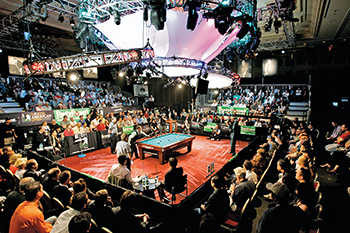
No expense was spared in the production of IPT events, including a sparkling arena to dazzle the masses.
Regardless of where blame lies, those who had the most to gain from the IPT adventure felt a real sense of loss once it was clear things weren’t going to turn out as advertised.
“I had a chance to win $500,000 and then I had to go try to win $10,000?” Morris said. “I lost a lot of motivation. I did a lot of soul searching at that time. For about a year there, I didn’t know what I was going to do. I was depressed for a while.
“It was real hard. I didn’t want to play at all. For a year, I was in a coma. I could’ve been on the “Walking Dead” — just walking around without an idea.”
Hohmann, another player who had profited immensely from the IPT’s short run, expressed similar feelings.
“It wasn’t like the tour ended at once,” he said. “It was a bit of a slow death — them dragging it out with exhibition matches. Of course I fell into a slump … It took me a few years to recover from that. You have these high expectations and then you’re back to playing in tournaments where you’re walking away with $2,000. It was hard.”
The End of Times
Once the players had been paid in full, Andrews met with Trudeau to discuss the IPT. More than $13 million had been invested, including prize money, production costs and marketing. The operation, already stripped to its bare minimum, was barely paying for itself.
The IPT, as it had been packaged from the beginning, was all but dead and buried. At that point, pool’s golden goose decided to pull the plug.
The slow death, as Hohmann put it, had come. But now, in 2016 and a decade after the cash was stacked on the pool table at the first event, the question still remains: Was the IPT a net positive or negative for pool?
“It was good,” Sigel said. “To this day, I defend the IPT whenever I hear someone talk about it. Add up all the money in the years before and after and it won’t come close to the $13 million Kevin put into the game.”
Sigel, who first hatched the concept of the IPT, agrees with Andrews, who was involved in the execution of that idea.
“Ultimately, it was good,” Andrews said. “If you remember what it was like before the IPT, it was very similar to what it is now. It was exactly like it is today … We created an entirely alternate universe for pool. It happened in a vacuum and ultimately I don’t think it had much of an effect on pool. It didn’t impact the actual state of the sport today.”
“He invested an amazing amount of money and it was great,” Appleton said. “I started playing American pool because of the IPT. I have that time to thank for my career and everything I’ve achieved since then.”
“Pool players can be some of the most loyal, trusting and straightforward people,” Andrews said, who continued to work with Trudeau until 2013. “Really the promoters are goofier than the players. The players show up, they pay their expenses, they pay the entry fees, they practice. They do all this stuff, and it’s such a basic thing: Pay them on time.
“I still hear about this. The money isn’t there or the added money was different than what was published … We were as guilty as anybody, but the players were overwhelmingly supportive.”
Orcollo Undefeated at Carom Room Fall Classic
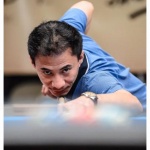 Early on, it looked as though one way or another, it was going to be over quickly.
Early on, it looked as though one way or another, it was going to be over quickly.
Dennis Orcollo and Johnny Archer met up in the finals of the $10,000-added Carom Room Fall Classic up in Benoit, WI, a 10-ball, bar table event held on the weekend of August 28-30. They broke and ran their way through the first five games of that final matchup, until, ahead by one, Orcollo jumped on Archer’s first dry break of the match to take a lead he’d never relinquish. The event, streamed live, by Ray “Big Truck” Hansen and his crew at PoolActionTV, drew 96 entrants to The Carom Room in Beloit, WI.
They’d met first in the hot seat match. Archer had just sent Josh Roberts to the loss side. Orcollo sent Jason Klatt over. Archer broke dry five times in the hot seat match that sent him to the semifinals 9-5.
Still playing on the loss side when the first money rounds came around were (among others) Shane Van Boening, Skyler Woodward, John Morra, and Tony Chohan. Billy Thorpe was still playing, too. He’d sent Van Boening to the loss side, and they were both working their way to a potential head-to-head rematch in the quarterfinals. Working on that loss side, Thorpe got by Chohan and Morra to pick up Klatt. Van Boening had defeated Jesse Bowman and Skyler Woodward to draw Roberts.
Roberts spoiled the Thorpe/Van Boening re-match by eliminating Van Boening, while Thorpe took Klatt out. Roberts then defeated Thorpe in the quarterfinals 9-6.
Roberts then ran into the buzz saw of Johnny Archer smelling the finish line. Mindful of his break problems in the hot seat match, Archer had spent much of the intervening time between the hot seat match and semifinal (during the quarterfinal match) practicing that break and it paid off. Roberts broke to get things underway, but Johnny took the first game and then, sunk three on his subsequent break to jump start his way to taking the second. On the third rack, Roberts broke dry, but left Archer a long, rail-first shot at the 1-ball, nestled against the 10-ball, pointed right at a 6-ball, sitting just off-center of the side pocket. Acting as though he did this sort of thing every day, Archer stroked the ball and sure enough – rail first, cue hit the 1-ball, 10 slid over, nudged the 6-ball out of the way and dropped into the side pocket.
3-0, Archer. He won six more to shut Roberts out and the re-match versus Orcullo was on.
Though Orcollo would win by four racks, he and Archer both were handed and squandered numerous opportunities. Immediately after Archer broke dry to give Orcullo the 4-2 lead, Orcollo broke dry to hand Archer his third rack. Archer then broke dry a second time, and for the second time, Orcollo made him pay. It was 5-3.
The 9th rack created a problem that was, much to Archer’s chagrine, solved by allowing Orcollo to break rack # 9 a second time. Within a shot or two of Orcollo’s initial break that saw three balls go down, the 1-ball was locked up in a tight pack of balls and could not, without foul, be touched. Archer and Orcollo took turns giving each other ball in hand, by shooting at a ball that either tied up the 1-ball even further or just moved a different ball, away from the pack, in some random direction. The game and match came to a halt, before it was determined, by TD David Coles, that the game was a stalemate, and that, by rule, Orcollo (the original breaker) would be allowed to break again.
Orcollo did so, made two balls and was looking at a decent table for a run when he put himself out of position, shooting at the 5-ball and gave the table to Archer. Archer, in much the same way, gave it right back and Orcollo finished it – 6-3.
Archer broke dry for the third straight time, but Orcollo chalked up another unforced error, missing a ball completely to give Archer ball-in-hand, and eventually, the game. It was 6-4 and still looking interesting.
A quick break-and-run for Orcollo moved him back out in front by three (7-4), before Archer broke dry for the fourth straight time. Again, Orcollo failed to capitalize, and when he turned the table over to Archer, Archer jumped on it to complete what proved to be his final winning rack.
Orcollo broke rack # 13, sinking two balls, and though he’d make a tricky 1-8 combination, the position result was not what he’d hoped for. He played a safety that left Archer snookered, and went on to reach the hill first at 8-5.
Archer broke the final game, and though he did sink a ball, he was left with a difficult shot on the 1-ball that he missed. Orcollo stepped to the table and completed his undefeated run to claim the Carom Room’s Fall Classic title.
Mosconi Junior
With the well-documented success of the Mosconi Cup and the emergence of the Queens Cup, it was only a matter of time before international team clashes reached the junior ranks.
Enter the Atlantic Challenge Cup, an event recently announced by the Billiard Congress of America (BCA) and the European Pocket Billiard Federation (EPBF). As with the Mosconi Cup, which pits players from the United States against a team of European stars, the Atlantic Challenge Cup will be a transatlantic clash. Four boys and two girls will represent Team USA and Team Europe at the inaugural Challenge, which will take place July 1-4, in Rankweil, Austria. Players must be 19 or younger.
“The future of the game lies in our ability to develop tomorrow’s players,” said BCA Chairman Mike Serra. “The prestige of competing in an event of this magnitude will further promote the game to today’s youth.”
Europe, through the EPBF, already enjoys a strong youth program, and EPBF officials suspect the addition of the Atlantic Challenge Cup will further fuel the efforts.
“We expect the desire from the players wanting to be included into the team will be very strong and will further increase the standard within pool,” said EPBF President Gre Leenders. A seven-person committee, chaired by longtime instructor and referee Rick Doner, was assigned by the Billiard Education Foundation to select the U.S. squad The committee included players Jeanette Lee, Johnny Archer and Laura Smith, along with instructor Randy Goettlicher, instructional author Phil Capelle and longtime tournament director Earl Munson, who will also serve as coach and captain for Team USA. The BCA was expected to announce the Team USA members on May 4.
Meanwhile, the EPBF announced its roster, which will include Germany’s Joshua Filler and Raphael Wall, each of whom earned a pair of gold medals at the 2014 Youth European Championships. Maxim Dudanets of Russia, currently ranked 34th on the Euro Tour, will also participate, as will Sweden’s Daniel Tanguud. Youth Euro Championships silver medalist Marharyta Fefilava of Belarus and youth 8-ball champion Kristina Tkach of Russia will round out the squad.
While details have yet to be determined, the four-day event is expected to be a race to 11.
Wilson Names Team USA Hopefuls
 As was his original intent, Mosconi Cup Team USA Captain Mark Wilson worked quickly to select the players who will compete for the final five roster spots for the 2014 event in December in Blackpool, England. Wilson announced the selection of eight players who will train and compete together through the summer, before the captain whittles the list down to the five players who will wear the red, white and blue in Blackpool.
As was his original intent, Mosconi Cup Team USA Captain Mark Wilson worked quickly to select the players who will compete for the final five roster spots for the 2014 event in December in Blackpool, England. Wilson announced the selection of eight players who will train and compete together through the summer, before the captain whittles the list down to the five players who will wear the red, white and blue in Blackpool.
Not surprisingly, Wilson tabbed America’s No. 1, Shane Van Boening, and immediately announced that he will expect the taciturn star to provide leadership to the 2014 squad. “Shane sets a great example,” Wilson said in a press release. “And I expect to rely on him for leadership this year.”
Wilson also named seven-time Mosconi Cup veteran Corey Deuel, who many thought should have been on the team in 2013, to the squad. John Schmidt, Oscar Dominguez and Brandon Shuff, each of whom has participated in one Mosconi Cup, were named to the team was well. Leaning on America’s youth, Wilson rounded out his selection with Southern Classic One-Pocket champion Justin Bergman, Derby City titlist Justin Hall and Connecticut’s Jeremy Sossei.
“I’m really excited by this team,” Wilson said. “Every player seems so genuinely appreciative and excited. They’re all willing to do whatever it takes to develop a strong team and a strong sense of unity.”
More interesting than who Wilson selected, of course, was the list of players who weren’t invited to “camp.” The most notable omission was Johnny Archer, whose string of 17 consecutive Mosconi Cup appearances will come to an end. Fourteen-time Cup participant Earl Strickland and nine-time team member Rodney Morris were also left off the roster. In fact, Van Boening will be the only holdover from the 2013 squad that lost 21-1 to Team Europe in Las Vegas.
“I didn’t interview those players,” Wilson admitted. “And I explained to Johnny that I thought it best to go in a completely different direction this year. A lot of it is about attitude. Last year I felt there was no sense of urgency. There seemed to be a sense that it was a yearend bonus, and if the team won, great.”
Another player conspicuous by his absence is Mike Dechaine, one of the most consistent American players over the past three years.
“I spoke to Mike,” said Wilson. “In the end I felt that his reputation among the players wasn’t a good fit at this stage for a team event like the Mosconi Cup.”
Wilson added that his plan is to get the players together several times over the summer and fall for practice and team bonding. Wilson said he planned to make the final cut to five players after the U.S. Open, and that Team USA would meet and practice together for a week at Lindenwood University near St. Louis before departing for London. The dates of the 2014 Mosconi Cup are Dec. 1-4.
Van Boening Tops at Super Billiards Expo
But with a new venue and new format, the champion remained Shane Van Boening. The reigning Player of the Year took his fourth Pro Players title, and second in a row, with an impressive run through a field of 61.
Starting with wins over Donnie Mills and Robb Saez, Van Beoning then ran into 2011 champ Ralf Souquet. The American dropped the second set, 8-6, but bounced back with a clinching 8-2 set to advance to the quarterfinals.
Souquet was hardly the only big name to be sidelined early. Efren Reyes drew German superstar Thorsten Hohmann in the first round — and the Filipino legend dropped consecutive sets to end an uncharacteristically quick event. Johnny Archer, Francisco Bustamante and Mika Immonen also crashed out before winning two sets.
In the quarterfinals, Van Boening took two close sets against Darren Appleton; Warren Kiamco edged Corey Deuel; Alex Pagulayan thumped Jeremy Sossei, and Hohmann outlasted Scotland’s Jayson Shaw.
In a rematch from the 2003 World Pool Championship, Hohmann took his spot in the final by edging Pagulayan. Van Boening then topped Kiamco in straight sets, 8-6 and 8-5, to take the other seat in the championship match.
Van Boening struck first in the final, taking the opening set, 8-6. He then worked his way to within a 10-ball of the title in the second when he got on the hill, 7-6. But Hohmann responded with a pair of racks to force a decisive third set.
In the final race-to-8, Van Boening turned a 3-2 lead into an insurmountable 7-2 advantage. Hohmann took a pair of racks to edge within shouting distance at 7-4, but Van Boening then broke and ran the 12th table for the 8-4 win.
His second consecutive Pro Players title netted Van Boening $10,000 while Hohmann pocketed $5,000 for his runner-up finish.
ESPN to Stream Mosconi Cup
Just hours before the 2012 Mosconi Cup kicks off in London, Matchroom Sport announced that ESPN will broadcast all of the action live on its ESPN3 network. Here is the full release from Matchroom Sport:
With the 2012 PartyPoker.com Mosconi Cup set to start at 2 Eastern time on Monday 10th December, pool fans across America will be able to follow all the action live on ESPN 3 as Team USA goes in search of Team Europe’s crown.
Taking place at the legendary York Hall in East London between Monday 10th and Thursday 13th December, this is the 19th annual running of pool’s biggest event as two five man teams from the USA and Europe go at it over four days of sheer adrenalized 9 ball action.
Team USA are aiming to win back the trophy they last won at MGM Grand in 2009. The Europeans retained their trophy in Vegas 12 months ago, defeating USA 11-7 in Vegas.
Captained by CJ Wiley, Team USA members Johnny Archer(Georgia), Shane Van Boening (South Dakota), Dennis Hatch (New York) and Mike Dechaine (Maine) are joined by rookie Brandon Shuff (Virgina) for Mosconi Cup XIX.
ESPN3 is ESPN’s multi-screen sports network, a live destination that delivers thousands of sports events annually and accessible online at WatchESPN.com, on smartphones and tablets via the WatchESPN app and through ESPN on Xbox LIVE to Gold members. It is currently available to 79 million homes at no additional cost to fans who receive their high-speed Internet connection or video subscription from an affiliated service provider. The network is also available at no cost to approximately 21 million U.S. college students and U.S.-based military personnel via computers connected to on-campus educational networks and on-base military networks.
Team USA Set for Mosconi Cup
Following from his undefeated run through last week’s U.S. Open 9-Ball Championship, Shane Van Boening cemented his place at the head of the American 2012 PartyPoker.com Mosconi Cup rankings to secure his spot on the team as one of the top two automatic spots.
“I’m so happy to be on my sixth appearance as Mosconi USA team member,” Van Boening said. “As I just won the U.S. Open, I know I’m playing well this year and will try my best to help the team take home the title.”
Such was Van Boening’s dominance of the five-event series that he beat the second placed player Mike Dechaine by an incredible 218 points. In his previous five Mosconi Cup appearances, the South Dakota Kid sports a record of 12 wins from 26 matches.
For second placed Dechaine it will be a return to the team following on from his debut in Las Vegas last year and he will be relishing the chance to show what he can do in front of a partisan, sold-out crowd at the York Hall, London, from December 10-13.
“I am very excited to compete in my second consecutive Mosconi Cup, especially with this one being in London,” Dechaine said. “With the crowds being heavily in Europe’s favor, this is without a doubt the team I’d want going against it.”
The first of the remaining three wildcard picks is Virginia’s Brandon Shuff, who caps off a fine season to make his Mosconi Cup debut at the age of 29.
“When I was growing up, it was an American pool player’s dream to play on the Mosconi Cup,” he said. “This is definitely a blessing and hard work is paying off and I’m excited for this accomplishment and I’ll be training hard to help our team bring that Cup back where it belongs.”
Back for his third Mosconi Cup is Dennis Hatch. An MVP in his 2009 debut when his gung-ho team spirit helped propel the team to victory, Hatch will be hoping for a successful return to the York Hall where he made his last Mosconi Cup appearance in 2010.
“It’s always an honor and privilege to represent the US,” he said. “I am so fired up and hungry that the only thing I plan on tasting while in Europe is victory, because I believe this is one of the best teams yet.”
The final spot in the team is filled by Georgia’s Johnny Archer who will be making a record-breaking 16th consecutive Mosconi Cup appearance. With a winning percentage of 53, the Scorpion made his debut at the event in 1996 and has been an ever-present since.
“It is an honor to represent the USA team for my 16th straight year,” he said. “And I will do whatever it takes to help the boys take that cup from York Hall and bring it back to America where it belongs.”
Dozen Remain in U.S. Open Hunt
VIRGINIA BEACH, Va. — If you’re looking for story lines at the 2012 U.S. Open 9-Ball Championship, the winners-side final four should provide plenty. Efren Reyes, Jose Parica, Alex Pagulayan and Shane Van Boening remain unbeaten. Young vs. old, Philippines vs. U.S., former champions chasing titles or an overdue contender closing in on his crown, the final 24 hours of the U.S. Open should be riveting.
Parica, 63, is chasing his first Open title after finished second in 2003. He will face the 29-year-old Van Boening, who has been absolutely dominant thus far. In a superb match against Ronnie Alcano — a rematch of the 2007 final, won by the American — Van Boening erased a late two-rack deficit to take an 11-10 victory.
On the other side of the bracket, Pagulayan and Reyes will square off. The Magician has been nothing short of magical in his march through the right side. He topped two-time reigning champ Darren Appleton, 11-10, on Thursday afternoon, then outlasted Wang Can, 11-7, that evening. On Friday, he then trumped Dennis Orcollo, leader of the Philippines’ next generation of stars, 11-7.
Over on the one-loss side of the bracket, it’s tough to find a player without top-tier credentials. Johnny Archer faces Darren Appleton, with the Englishman plodding through the left side in search of his third straight U.S. Open title. World 9-Ball champ Chang Jung-Lin, China’s Li Hewen and Netherlander Niels Feijen top an impressive international class of hopefuls.
Stay tuned, as updates will be posted as each round of play concludes.
U.S. Open Primed for Big Weekend
VIRGINIA BEACH, Va. — Heading into the final two days of the 2012 U.S. Open 9-Ball Championships, it’s clear that the strong have survived. At the conclusion of play on the winners side on Thursday night, just eight players remained. And that octet packed plenty of star power.
Former champions Shane Van Boening, Alex Pagulayan and Johnny Archer are all chasing title No. 2. But in perhaps the most thrilling story of the U.S. Open to this point, 58-year-old Efren Reyes strung together five victories — including an electrifying 11-10 win over two-time defending champ Darren Appleton — to put himself in contention for the Open crown. He will square off against countryman Dennis Orcollo on Friday. Pagulayan and Archer will square off in the other match on that side of the bracket.
Scotland’s Jayson Shaw will face 63-year-old Jose Parica on the other side of the bracket. Parica, runner-up at the 2003 U.S. Open, advanced via a dominant victory over a resurgent Earl Strickland, 11-5. The winner of that set will then face the victor in Shane Van Boening’s match against Ronnie Alcano, a rematch of the 2007 U.S. Open won by the American.
While eight players have two bullets left in their revolvers, the left side is packed with championship-caliber talent. Most notably, late Thursday evening, Darren Appleton trailed American Oscar Dominguez. In search of his third-straight title, the Englishman was struggling to rally in the second match after his heart-breaking loss to Reyes.
Leading the charge on the one-loss side, Japan’s Yukio Akagariyama, China’s Li Hewen and Taiwan’s Chang Jung-Lin are major title winners seeking glory on American soil. Europe’s Albin Ouschan, brother of women’s star Jasmin and rising star on the EuroTour, joins England’s Chris Melling in the title hunt. American hopes settle on Corey Deuel, who dropped a Thursday night set to Jayson Shaw, and five-time titlist Strickland.

